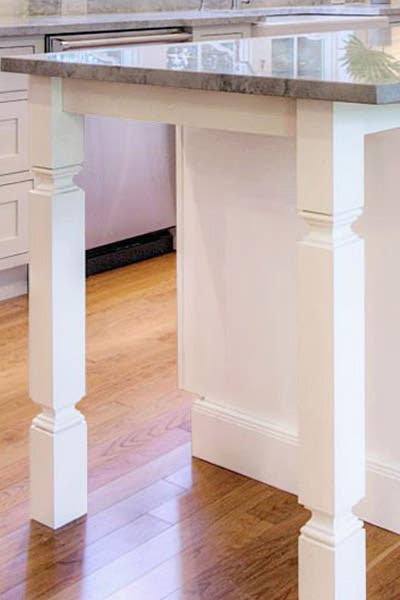A Guide to Selecting the Perfect Legs For Cooking Area Island for Your Home
Choosing the optimal legs for your cooking area island is a nuanced decision that impacts both the performance and visual appeal of this central area. As you consider these aspects, it becomes evident that the right legs can change not just the look of your kitchen but also its functionality for years to come.

Recognizing Kitchen Island Legs
When picking legs for a kitchen area island, it's necessary to understand their practical and aesthetic functions in the overall style. The legs function as an important support system, making sure security and longevity for the island, which typically works as a work area, eating area, or collecting spot. The choice of material and building and construction method need to be robust adequate to hold up against daily usage and potential wear.
In addition to their architectural duties, legs add dramatically to the island's visual charm. They can improve the kitchen area's style, whether with conventional, modern, or eclectic layouts. The height and percentage of the legs are also vital considerations; they should integrate with the island's countertop height while making sure comfortable seating for those making use of the room.
Moreover, the leg design can affect the total flow of the kitchen area. Open, airy leg styles can create a feeling of lightness, while strong, considerable legs may communicate a more grounded and stable visual - Legs For Kitchen Island. Comprehending these aesthetic and functional elements will certainly guide homeowners in making informed options that match their kitchen's style and enhance its usability
Popular Styles and Products
The choice of legs for a kitchen island includes a selection of prominent designs and products, each offering special qualities that can boost both capability and looks. Standard legs normally exhibit elaborate details and workmanship, boosting classic cooking area designs.

Elevation and Stability Considerations

Stability is an additional vital factor to consider. The legs of the cooking area island need to give appropriate support, making sure that the framework can endure everyday usage without changing or tottering. Material option plays a substantial role in stability; steel legs, for instance, have a tendency to provide better strength compared to timber. Furthermore, making certain that the island is safely anchored to the floor or wall can boost security, specifically for larger islands that may bear substantial weight.
Matching Your Kitchen Area Aesthetic
Choosing the special info right legs for your kitchen area island exceeds functionality; it additionally plays a considerable duty in the total visual of the room. When selecting legs, consider the layout style of your cooking area. For a modern look, streamlined steel or minimalist layouts can develop a clean, contemporary vibe. On the other hand, rustic or conventional kitchens usually benefit from wooden legs with complex outlining or a troubled finish, enhancing warmth and character.
Legs that match or comparison with your island's surface area and bordering cabinets can develop aesthetic harmony or striking focal check factors. Furthermore, consider the surface of the legs; matte, shiny, or distinctive coatings can significantly influence the general feeling of the kitchen area.
Setup and Upkeep Tips
Mounting kitchen island legs requires mindful attention to information to guarantee both security and visual charm. Begin by picking an appropriate area for your island, ensuring it is degree and has adequate room for motion. Utilize a stud finder to find wall surface studs if you are connecting the legs to a wall surface or utilizing brackets for added support. Mark the placement of the legs precisely before exploration.
When safeguarding the legs, make use check out this site of high-grade screws and, if needed, timber glue for added toughness. For steel legs, ensure that you are using appropriate supports and devices to avoid damage to your flooring. It is suggested to look for levelness after installation, making changes as needed to avoid tottering.
Tidy the legs with a suitable cleaner, staying clear of unpleasant materials that might damage the surface. By complying with these setup and upkeep pointers, you can ensure that your kitchen island legs continue to be both visually appealing and practical.
Conclusion
Finally, selecting the proper legs for a kitchen area island demands cautious factor to consider of elevation, stability, and visual compatibility. By selecting ideal materials and styles that align with the general kitchen design, functionality can be boosted while maintaining visual allure. Correct setup and ongoing upkeep further add to the toughness and durability of the cooking area island. Eventually, thoughtful leg selection plays a critical duty in elevating both the practicality and design of the cooking area area.
When picking legs for a kitchen island, it's vital to recognize their functional and aesthetic duties in the general layout. Open, ventilated leg designs can produce a feeling of lightness, while strong, substantial legs might communicate a more grounded and stable visual. The legs of the cooking area island ought to supply ample assistance, guaranteeing that the framework can stand up to daily usage without tottering or shifting.Setting up kitchen area island legs calls for mindful attention to detail to make sure both security and aesthetic appeal.In conclusion, selecting the proper legs for a cooking area island requires cautious factor to consider of elevation, stability, and visual compatibility.